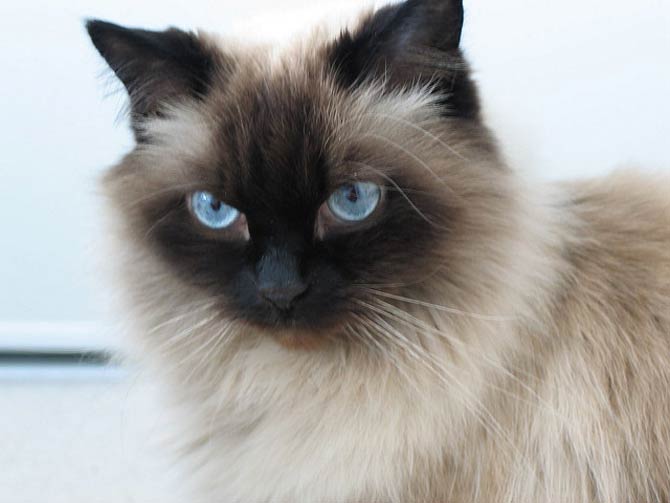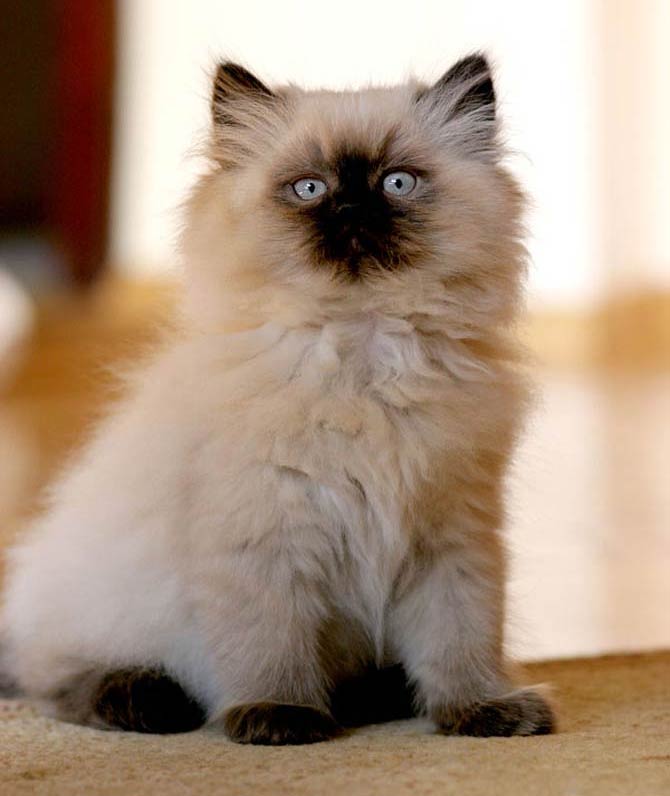Himalayan Persian, Colourpoint Persian
No less popular than Persian cat and as dignified as it. No wonder – the Himalayan breed was created thanks to the Persian breed. Their similarity is so striking that by many felinological organizations – including FIFe – Himmy is classified as a subtype of the Persian breed. However, this does not change the fact that the Himalayan breed has many unique features that are very clear to its lovers.
Names
Himalayan cat, Himalayan Persian, Colourpoint Persian, Himalayan Persian, Colourpoint Persian, Longhaired Colourpoint, Siamese–Persian.
Nicknames: Himmy

The origin of the breed
The Himalayan breed did not arise naturally, but by crossing a Persian cat with a Siamese cat in 1931.
Thanks to this genetic mix, cats covered with long hair (inherited from Persian cats) appeared in the world in the colourpoint color variety with blue irises (as in Siamese cats). The first Himalayan kitten was named Newton.
Nowadays, the Himalayan cat, depending on the felinological federation, is considered a separate breed or variety of the Persian cat. The CFA, for example, recognized the Himalayan as an independent breed in the late 1950s, but reclassified it as a color variant of the Persian in 1984. It has also been recognized as a subtype of the Persian by the ACA and ICA. It has been classified as a separate breed in the AACE, ACFA and TCA standards.

Characteristic
Appearance
Persian-shaped silhouette – characterized by rounded, stocky shapes and short limbs. Due to the latter trait, Himmy may have trouble making long jumps. However, since the 1960s, there are specimens more similar to Siamese cats.
The shape of the head (or more precisely the face), similar to the Persians, may be doll-faced (short but not concave) or peke-faced (extremely flattened, almost concave face, causing breathing problems). The small nose is directly between the large, round eyes. Domestic cats that do not take part in shows usually have a doll face type, while the peke face type is more desirable for show cats. Sometimes there are also individuals with smaller than usual eyes and a more elongated mouth – “ultra-typed”. This does not affect the classification – all three head shapes mentioned are specific to Himmy.

Fur
The coat is dense, shiny and fine. There is a ruff around the neck and a jabot between the front legs. There are tufts of long hair on the ears, and the tail resembles a plume. The acceptable color variants include, among others: chocolate, lilac, blue, blue-cream, red-cream, cream, seal, red, tortoiseshell-chocolate. An inseparable element of the Himmy’s color is a dark mask, ears, paws and tail.
Eyes
The color of the iris, unlike Persian and exotic cats, always has a shade of deep blue.

Temperament
The personality is largely inherited from the Persian cat. Similarly to it, it is obedient, sweet and calm. It becomes an ornament of every home and a faithful companion of man. It likes to spend time on the owners’ lap, it can also play with children, provided that this game does not become a circus, in which the cat will be treated like a clown.
It prefers gentle caresses and playing tag, so in the case of Himmy, interactive toys that it will be able to run behind will work well. However, it does not mind if a fragile little man carries it in a doll’s pram.
It only focuses on family members and is unlikely to trust strangers. The guest has to earn its sympathy, so not everyone can pet it.
It is not a loud cat, it prefers peace and a sweet routine. Only when it needs something, such as food or when it wants to show its love for the owner with a cute, soft voice.
As one of the few breeds, it will not climb curtains or jump over furniture. It feels good on the ground and low lairs. It does not become hysterical if the owners leave it alone for a short time. When it is alone with itself, it lies down in a chair or bed until its beloved owners return home. After the owners return, it lets them know about its presence, but is not intrusive.

Health condition
Due to their relationship with the Persian cat, the Himalayan cats may be carriers of the gene responsible for polycystic kidney disease (PKD). However, not all individuals are carriers of these genes.
Flat mouths require care in order to avoid infections and dirt. It is recommended to dry the corners of the eyes daily to reduce a little excess tearing. A flattened skull is also responsible for breathing problems, malocclusions and complications during childbirth.
In addition, cats of this breed are sensitive to heat – the narrowing of the nostrils makes the body unable to regulate its temperature efficiently. There are also eye problems within the breed, such as excessive tearing, cherry eye, eyelid curl, and retinal atrophy.

Detailed data / dimensions (size)
Himalayan cat, Himalayan Persian, Colourpoint Persian
- Height at the withers: 25-30 cm (9.8 – 11.8 in)
- Weight: 4-5 kg (8.8 – 11 lb)
- Lifespan: 9-15 years

Himalayan – interesting facts
- In the 1984 animated series “Heathcliff and the Catillac Cats”, there was a Himalayan cat named Hector. He had a purple tie, a gray headband, an eighties hairstyle, and had a New Jersey accent.
- Jinx from Meet the Parents is a Himalayan cat.
- A crossbreed of a Himalayan cat with a Persian cat named Colonel Meow became an Internet star in 2012, and in 2014 it was entered in the Guinness Book of Records as the cat with the longest hair (approx. 23 cm / 9 in).



















